Related Research Articles

Excalibur is the legendary sword of King Arthur, sometimes also attributed with magical powers or associated with the rightful sovereignty of Britain. Excalibur and the Sword in the Stone are sometimes said to be the same weapon, but in most versions they are considered separate. Excalibur was associated with the Arthurian legend very early on. In Welsh, it is called Caledfwlch; in Cornish, Calesvol; in Breton, Kaledvoulc'h; and in Latin, Caliburnus.
In Welsh mythology, Amaethon was the god of agriculture, and the son of the goddess Dôn. His name means "labourer" or "ploughman", and he is cited as being responsible for the Cad Goddeu, or "Battle of Trees", between the lord of the otherworld, Arawn, and the Children of Dôn.
Lleu Llaw Gyffes is a hero of Welsh mythology. He appears most prominently in the Fourth Branch of the Mabinogi, the tale of Math fab Mathonwy, which tells the tale of his birth, his marriage, his death, his resurrection and his accession to the throne of Gwynedd. He is a warrior and magician, invariably associated with his uncle Gwydion.
Annwn, Annwfn, or Annwfyn is the Otherworld in Welsh mythology. Ruled by Arawn, it was essentially a world of delights and eternal youth where disease was absent and food was ever-abundant. It became identified with the Christian afterlife in paradise.
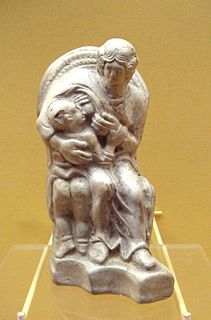
In Celtic mythology, Dea Matrona was the goddess who gives her name to the river Marne in Gaul.
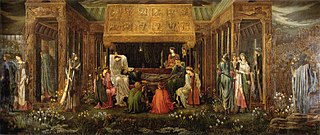
Avalon, sometimes written Avallon or Avilion, is a legendary island featured in the Arthurian legend. It first appears in Geoffrey of Monmouth's 1136 pseudo-historical account Historia Regum Britanniae as the place where King Arthur's sword Excalibur was forged and later where Arthur was taken to recover from his wounds after the Battle of Camlann. Avalon was associated from an early date with mystical practices and figures such as Morgan le Fay. It is traditionally identified as the former island of Glastonbury Tor.

Uther Pendragon, also known as King Uther, is a legendary king of sub-Roman Britain and the father of King Arthur. A few minor references to Uther appear in Old Welsh poems, but his biography was first written down by Geoffrey of Monmouth in his Historia Regum Britanniae, and Geoffrey's account of the character was used in most later versions. He is a fairly ambiguous individual throughout the literature, but is described as a strong king and a defender of the people.

The Matter of Britain is the body of Medieval literature and legendary material associated with Great Britain and Brittany, and the legendary kings and heroes associated with it, particularly King Arthur. It was one of the three great story cycles recalled repeatedly in medieval literature, together with the Matter of France, which concerned the legends of Charlemagne, and the Matter of Rome, which included material derived from or inspired by classical mythology.

Coel, also called Coel Hen is a figure prominent in Welsh literature and legend since the Middle Ages. Early Welsh tradition knew of a Coel Hen, a circa 4th century leader in Roman or Sub-Roman Britain and the progenitor of several kingly lines in the Hen Ogledd, the Brittonic-speaking part of what is now northern England and southern Scotland. Later medieval legend told of a Coel, apparently derived from Coel Hen, who was the father of Saint Helena and the grandfather of Roman Emperor Constantine the Great. Other similarly named characters may be confused or conflated with the Welsh Coel. The legendary "King Coel" is sometimes supposed to be the historical basis for the popular nursery rhyme "Old King Cole", but this has been said to be unlikely.

Morgan le Fay, alternatively known as Morgan[n]a, Morgain[a/e], Morg[a]ne, Morgant[e], Morge[i]n, and Morgue[in] among other names and spellings, is a powerful enchantress in the Arthurian legend. Early appearances of Morgan do not elaborate her character beyond her role as a goddess, a fay, a witch, or a sorceress, generally benevolent and related to King Arthur as his magical saviour and protector. Her prominence increased over time, as did her moral ambivalence, and in some texts there is an evolutionary transformation of her to an antagonist, particularly as portrayed in cyclical prose such as the Lancelot-Grail and the Post-Vulgate Cycle. A significant aspect in many of Morgan's medieval and later iterations is the unpredictable duality of her nature, with potential for both good and evil.
Lot, Loth or Lothus is the king of Lothian, the realm of the Picts in the Arthurian legend. Such a ruler first appeared late in the 1st millennium's hagiographical material concerning Saint Kentigern, which feature a Leudonus, king of Leudonia, a Latin name for Lothian. In the 12th century, Geoffrey of Monmouth adapted this to Lot, king of Lothian, in his influential chronicle Historia Regum Britanniae, portraying him as King Arthur's brother-in-law and ally. In the wake of Geoffrey's writings, Lot appeared regularly in later romance.
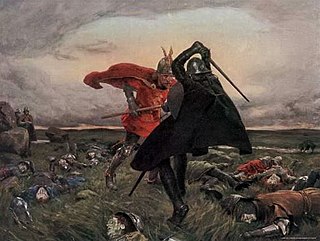
The Battle of Camlann is reputed to have been the final battle of King Arthur during the early 6th century, in which he either died or was fatally wounded while fighting either with or against Mordred, who is also said to have died. Its depictions in the medieval legend of Arthur are generally based on that in the pseudo-chronicle Historia Regum Britanniae. These variants include the later chivalric romance tradition, with the version included in Le Morte d'Arthur being popular today.
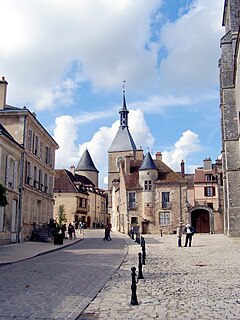
Avallon is a town in the Yonne department in Bourgogne-Franche-Comté in central-eastern France.
Prydain is the modern Welsh name for Britain.
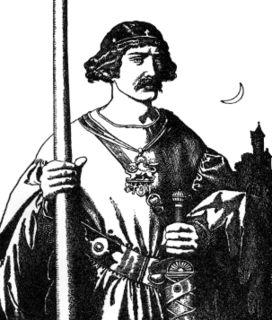
Sir Yvain, also known as Ywain, Owain, Uwain(e), Ewaine, etc., is a knight of the Round Table in Arthurian legend, wherein he is often the son of King Urien of Gorre and the sorceress Morgan le Fay. The historical Owain mab Urien, on whom the literary character is based, was the king of Rheged in Great Britain during the late 6th century.

King Arthur's family grew throughout the centuries with King Arthur's legend. Several of the legendary members of this mythical king's family became leading characters of mythical tales in their own right.
Emain Ablach is a mythical island paradise in Irish mythology. It is often regarded as the realm of the sea god Manannán Mac Lir and identified with either the Isle of Man or the Isle of Arran. According to the medieval Irish poem Baile Suthain Sith Eamhna, the god Lug Lamfada was reared in Emain Ablach. In another poem from the 14th century, Emain Ablach is described as being filled with swans and yews.
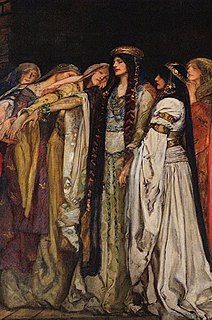
The Land of Maidens is a motif in Irish mythology and medieval literature, especially in the chivalric romance genre. The latter often also features a castle instead of an island, sometimes known as the Castle of Maidens.
References
- ↑ Koch, J. T. (ed.), Celtic culture: a historical encyclopedia, ABC-CLIO, 2006, p. 146.
- ↑ Bernhard Maier, Dictionary of Celtic Religion and Culture (trans. Cyril Edwards, The Boydell Press, 1997).
- ↑ . University of Wales Centre for Advanced Welsh and Celtic Studies. (See also this page for background and disclaimers.) Cf. also the University of Leiden database Archived 2006-02-11 at the Wayback Machine .
Pen. 147. trans. Rachel Bromwich. Trioedd Ynys Prydein. Cardiff: UWP, 1963. p.459.
| This article relating to a Celtic myth or legend is a stub. You can help Wikipedia by expanding it. |